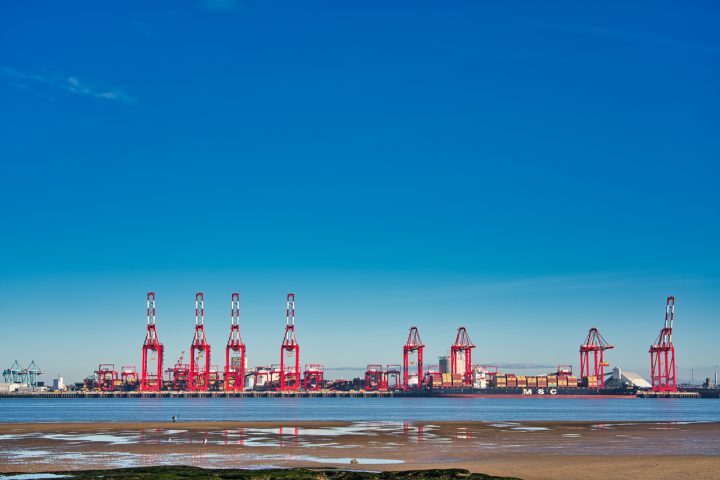Supply chains in the UK hit headlines in Autumn last year when global container capacity restrictions and haulage driver shortages choked inland cargo transport.
The Port of Felixstowe, handling more than a third of the nation’s containers, bore the brunt of congestion, with major shipping lines including Maersk omitting calls due to “exceptional” waiting times and lack of fluid transport options further into the country.
Almost one third of Felixstowe’s calls were omitted as carriers looked to avoid congestion at Britain’s biggest container port. At the time, analysis suggested that nearly $2 billion of trade imports could have been impacted due to congestion at Felixstowe.
The UK is a net importer, moving 95% of its import freight by sea in 2019. Inland, the nation is equally reliant on carbon-producing Heavy Goods Vehicles (HGVs), of which around 70% of its goods are transported.
Ongoing troubles
Increasing numbers of empty containers, triggered by an increase in imports due to the pandemic, has led to backlogs and increased traffic in logistics nodes around the country.
“Container lines are not waiting at British ports to retrieve empty containers to return to Asia,” Richard Ballantyne OBE, CEO of British Ports Association (BPA) told Port Technology International.
“Because freight rates are so high, it’s not cost-effective for vessels to wait for empties to be loaded onto ships: they want to get back to Asia to pick up full containers. As they’re rushing back around to Asia, [the UK] as importers are not able to send boxes back.”
Congestion facing British ports has partially abated. Shippers are favouring cargo destinations away from the southeast, with container ports further north such as Liverpool and the Port of Tyne (which welcomed its first direct Chinese service earlier this month) receiving increased levels of cargo.
As supply chains continue to reel from a lack of capacity, port operations could be out of the norm into the first quarter of 2023, Ballantyne said.
New options
The well-documented driver shortage has opened up opportunities to consider alternative ways of moving goods through the country.
It is now a common occurrence to see new rail freight networks – Direct Rail Services and Tesco, and GB Railfreight’s latest Felixstowe service, to name just two – as emerging low-carbon alternatives to moving goods inland.
Taking into account driver shortages in the southeast, and environmental aspirations of getting more goods off the road and onto rail, there is definitely “a good argument,” Ballantyne says, to turn to furthered rail investment as a salve to bottlenecks faced around logistics hubs in the southeast.
“Coupled with the fact that we have a huge variety of different types of ports,” Ballantyne adds, sizeable general cargo hauls such as wind turbines could benefit from diverse transport modes to get cargo to its destination.
Turning to feedering and shortsea shipping in addition to coastal shipping, the UK’s island geography could open the door to moving goods coastally or through its limited waterways to also reduce carbon impact and offer alternative options to shippers.
Unifeeder, for example, offers a weekly feedering rotation including the Port of Dunkirk, London Gateway, and Teesport. A focus to coastal and feedering could be a long-term driver in diversifying cargo flows with the UK.
However, challenges in the modal shift for the UK differ to those of its European mainland counterparts, Ballantyne says.
“As an island nation, we are not the same as continental Europe where you have long hauls of railway lines or barge routes,” he explained. “You are going to find that transporting by road here has an efficiency advantage. The arguments against other forms of transport are price and cost.”
The UK Government, which championed its 10 point plan for a Green Industrial Revolution back in 2020, could start prioritising freight paths in rail as a greener alternative to the HGV industry.
For the nation’s greenifying of ports, BPA is calling on the government to decarbonise through increasing the number of shore power facilities; introducing more electricity-powered cargo handling equipment; and creating grant structures to prioritise freight through rail and coastal transport.
Highways remain king
Immediate priorities will, however, return to road freight.
For BPA and its members, public authorities can focus on last-mile connections into those major freight hubs of Felixstowe, Liverpool, Southampton, or the Port of Tyne as key areas of improvement.
A balanced national capital investment on traffic management systems, enhanced visibility of traffic levels outside a container terminal, or even improved infrastructure through roundabouts could go some way in stemming congestion, Ballantyne notes.
“Investment in the secondary road network and last-mile connections are a priority,” he said. “The UK’s ports are not like in Europe that has Hamburg, Antwerp, or Rotterdam a major strategic hubs: we’re much more spread out.
“Making sure investment goes across the UK is a key concern for us; if the government starts investing in one route, others lose out on competition. There has to be a level-handed and even approach to this.”
On 8 February 2022, PTI will be holding its Intermodal Freight Forum Europe delving into the pressing challenges and trends in intermodal freight transport. The event is set to bring together senior decision-makers from the intermodal transport network, addressing a wide range of issues from data standardisation to the lack of capacity in ports and rail.
Registration for the event can be done here.



